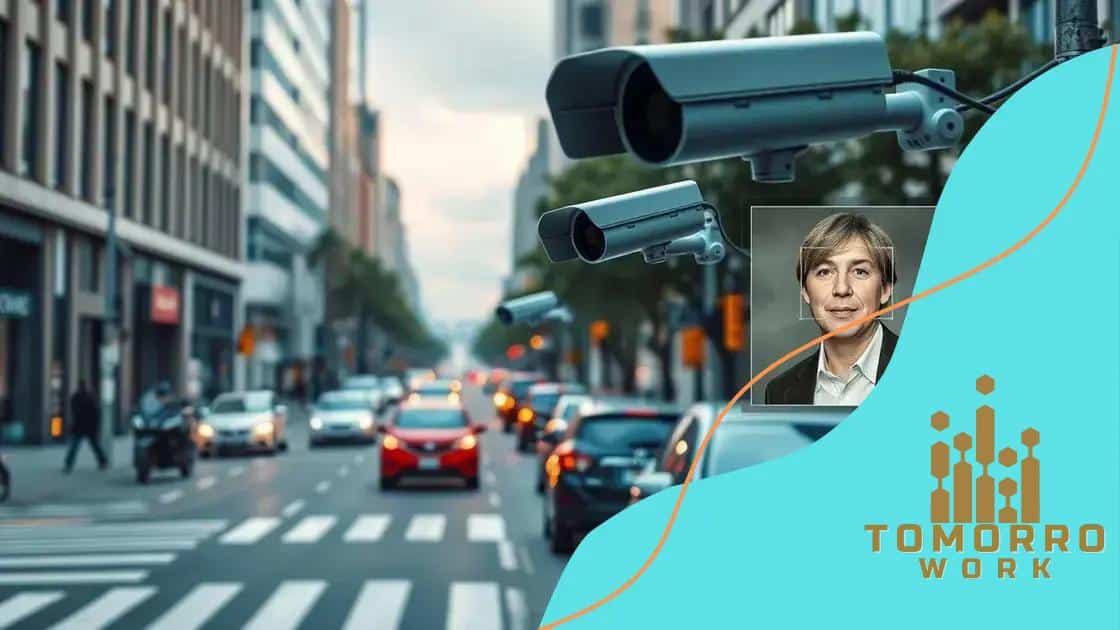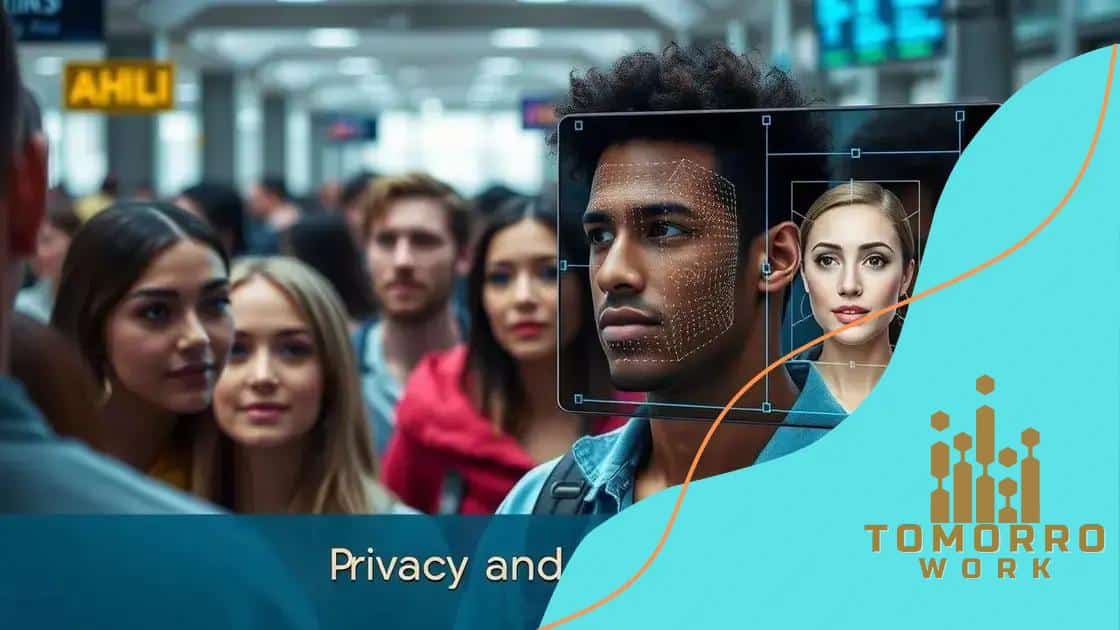The role of facial recognition in enhancing public safety

Advertisements
The role of facial recognition in enhancing public safety includes improving crime prevention, streamlining suspect identification, and enabling quick responses to emergencies, while also raising ethical concerns regarding privacy and accuracy.
The role of facial recognition in enhancing public safety is becoming increasingly significant in our daily lives. You might wonder how this technology impacts our safety and privacy. In this article, we’ll explore its applications and challenges.
Advertisements
Understanding facial recognition technology
Understanding facial recognition technology is essential as it plays a critical role in modern security systems. This technology can identify individuals by analyzing their facial features.
To grasp how facial recognition works, we should look at its main components. Primarily, it uses algorithms that compare a person’s features to a database of known faces. Artificial intelligence enhances these algorithms, allowing for more accurate identification.
How It Works
Face detection is the first step, where the system locates a face within an image. Then, it extracts facial landmarks, such as the distance between the eyes or the shape of the jaw. This data is converted into a numerical code, which is then compared against stored profiles.
Advertisements
Main Applications
- Law enforcement uses facial recognition to track down suspects.
- Security systems in buildings and airports enhance safety measures.
- Smartphone technology employs this for user identification.
- Social media platforms utilize it to tag friends in photos.
Despite its strengths, facial recognition technology is not without challenges. Privacy concerns arise as many fear constant monitoring. Moreover, there are issues with accuracy, especially concerning diverse facial features. Continuous improvements in algorithms aim to address these discrepancies.
As society becomes more familiar with facial recognition, we must balance its benefits with potential risks. Understanding this technology equips us to engage in relevant discussions regarding safety and privacy.
Benefits of facial recognition for law enforcement
The benefits of facial recognition for law enforcement are significant and can greatly improve public safety. This technology helps officers quickly identify suspects and locate missing persons.
With advanced algorithms, facial recognition can analyze hundreds of faces in real-time. This makes it easier for law enforcement agencies to respond to incidents promptly. When a crime occurs, having access to facial recognition data can aid in solving the case faster.
Speed and Accuracy
One of the major advantages is speed. Officers can quickly search through databases to find a match. Moreover, accuracy has improved significantly over the years, which helps reduce false positives.
Enhanced Crime Prevention
- Facial recognition systems can monitor crowded areas, enhancing security during public events.
- They enable faster response times during emergencies.
- Identifying potential threats before they escalate reduces crime rates.
- Providing information about known offenders helps in preventing criminal activities.
By utilizing facial recognition, law enforcement agencies can build more effective strategies to combat crime. This technology not only aids in investigations but also acts as a deterrent against criminal behavior. The mere presence of these systems can discourage criminal activities in public spaces.
As cities implement this technology, they often see a reduction in crime rates. Less crime creates safer communities, allowing citizens to feel more secure in their daily lives. However, the use of facial recognition also raises ethical questions. Balancing safety with privacy rights is crucial for its effective application.
Challenges of implementing facial recognition

Challenges of implementing facial recognition technology can impact its effectiveness and acceptance. Despite the benefits, various issues arise when integrating this system into law enforcement and public safety protocols.
First and foremost, privacy concerns are a significant obstacle. Many people worry about being constantly monitored, leading to potential abuse of this powerful tool. The lack of clear regulations can further complicate the situation.
Data Security
Another challenge lies in data security. Protecting sensitive information from cyberattacks is crucial. If hackers gain access to facial recognition databases, they can misuse personal data, resulting in severe consequences for individuals and organizations.
Accuracy Issues
- Facial recognition systems may struggle with accurately identifying individuals from diverse ethnic backgrounds.
- Lighting conditions and camera angles can reduce the reliability of identification.
- False positives can lead to wrongful accusations, damaging innocent people’s lives.
- Variations in appearance, such as changes in hairstyle or facial hair, can also affect recognition.
The implementation of facial recognition must prioritize transparency and ethical considerations. Many individuals feel uncomfortable if they are not informed about how their data is being used. Encouraging dialogue between authorities and the public can alleviate some concerns, ensuring citizens feel heard.
Finding a balance between the advantages of facial recognition technology and its challenges is essential. Ongoing research and development focus on improving accuracy while addressing privacy concerns. This ongoing dialogue is necessary to create a responsible framework that protects individual rights while enhancing public safety.
Ethical concerns surrounding facial recognition
Ethical concerns surrounding facial recognition technology have become a hot topic in discussions about privacy and civil liberties. As this technology gains widespread use, it raises important questions about how personal data is handled.
One of the main ethical issues is the potential for bias in facial recognition systems. Studies have shown that these systems can perform differently based on race and gender. For example, some algorithms may misidentify individuals from minority groups more frequently than others. This raises concerns about discrimination in law enforcement and other applications.
Privacy Risks
Another significant concern involves privacy. Many people feel uncomfortable knowing that they are being constantly monitored. The lack of clear consent processes raises questions about whether individuals are even aware that their images are being captured and stored.
Accountability and Transparency
- Organizations must be transparent about how they use facial recognition technology.
- Clear guidelines are needed to ensure accountability for any misuse or errors.
- Public trust can only be built if citizens are informed about data retention policies.
- Engaging communities in decision-making can help address ethical concerns.
Moreover, the potential for misuse of facial recognition technology is alarming. Law enforcement agencies may use it to track individuals without warrants, leading to unauthorized surveillance. The possibility of hacking and the misuse of sensitive data make these ethical concerns even more pressing.
As we continue to develop and implement facial recognition systems, we must prioritize ethical considerations. Building a framework that respects individual rights while ensuring safety is crucial to fostering a responsible approach to this technology.
Future trends in public safety technology
Future trends in public safety technology will shape how communities address crime and safety issues. As technology evolves, innovative solutions will emerge to improve efficiency and effectiveness.
One key trend is the integration of artificial intelligence in public safety systems. AI can analyze vast amounts of data quickly, helping agencies make informed decisions. Predictive policing is an area where AI shows promise, allowing law enforcement to anticipate crimes before they happen.
Smart Cities
Additionally, the rise of smart cities will transform public safety. These urban areas use interconnected devices to monitor and manage resources effectively. With sensors and cameras, cities can track trends in real-time, enabling quicker responses to incidents.
Improved Communication
- Enhanced communication tools will foster collaboration among emergency services.
- Mobile applications for reporting crimes will empower citizens to participate.
- Data-sharing platforms will help different agencies coordinate during emergencies.
- Social media will continue to play a crucial role in disseminating information.
Moreover, facial recognition technology will become more refined and widely accepted. As systems improve, they will offer greater accuracy, addressing concerns over biases and privacy. However, the ethical use of this technology will remain a key discussion point.
As we move forward, the focus will shift toward finding a balance between technological advancements and individual rights. Public safety technologies must enhance security without infringing on privacy. Collaboration among authorities, communities, and tech developers will be vital in shaping a safer future.
FAQ – Frequently Asked Questions about Facial Recognition in Public Safety
What are the primary benefits of facial recognition technology for public safety?
Facial recognition technology enhances crime prevention, helps identify suspects swiftly, and improves overall response times in emergencies.
What ethical concerns are associated with facial recognition?
Ethical concerns include privacy issues, potential bias in identification, and the risk of misuse by authorities without proper regulation.
How can technology improve public safety in smart cities?
In smart cities, interconnected devices can monitor real-time data, enabling quicker responses to incidents and more effective resource management.
What challenges does facial recognition technology face in implementation?
Challenges include ensuring data security, addressing inaccuracies, public resistance due to privacy fears, and the need for clear regulations.





